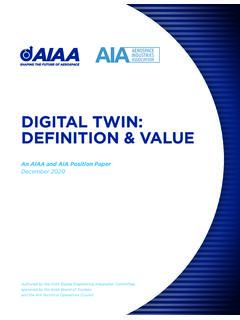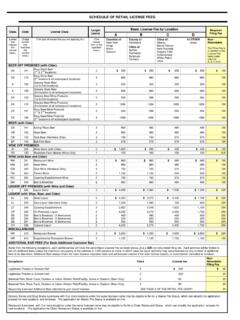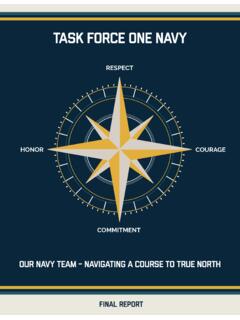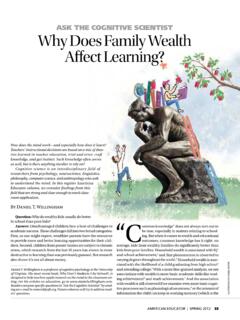Transcription of Responding to Extreme Weather and Climate Events
1 Responding to Extreme Weather and Climate Events Adaptation Strategies and Information Needs In recent years, communities have faced a variety of Extreme Weather and Climate Events , which have become more severe, more frequent, and more costly. From drought to storms to tidal surges, these Events have devastating impacts on our nation s critical infrastructure, including our drinking water and wastewater systems. Because the single biggest threat to human health and economic livelihood is lack of access to clean and safe water, water service providers must be prepared to deal with changing Weather rising public concern about Extreme Weather Events , a forum of drinking water, stormwater, and wastewater utility practitioners called on national organizations to help advance and share knowledge on preparing for, and Responding to, such Events .
2 This workshop series is intended to contribute to the national following case study series is based on workshops in six communities that have experienced Extreme Events , including floods, storms and derechos, sea level rise and storm surge, drought, and unseasonable frost. These Case Study Highlight: QFor Utility Managers: Lessons learned on building resilience, including useful tools and data sources QFor Policy Makers and the Research Community: Information on how water utilities plan, including information needs QFor Communities: Opportunities for dialogueA final report will be available late 2013. Central TexasRussianRiverLower Missouri RiverApalachicola-Chattahoochee-FlintNat ional CapitalAreaTidewater VirginiaExtreme Weather Event Workshop LocationsAs Extreme Weather Events appear to be more commonplace and have the potential to disrupt all types of water services, a forum of drinking water, stormwater, and wastewater utility practitioners called for a collaborative approach to advancing industry knowledge.
3 Through a series of regional workshops, WERF and WaterRF, along with collaborating partners NOAA, EPA, Concurrent Technologies Corporation, and Noblis, have begun documenting experiences and lessons learned and synthesizing collective information on Weather -related data needs. Key outcomes and findings from these workshops are highlighted Nature of Extreme Events : Instead of one dominant event, localities are dealing with multiple types and occurrences of Extreme Events , many of which have become more severe and more frequent in recent Services as Critical Infrastructure: Water services are critical, and water infrastructure must be Management: The community must understand their risk and define their risk Response and Long-Term Planning: To build resilience, water utilities and communities must embrace both emergency response and long- term preparedness.
4 Community Decision-Making within a Watershed: The complex array of decisions needed to support resilience within a watershed requires coordination across water service areas and jurisdictional boundaries. Leadership and Innovation: Communities need leadership to help navigate the path to Engagement in Acquiring Information and Tools: There is no silver-bullet decision support tool. Multi-Disciplinary Collaboration: Multi-disciplinary collaboration and communication increases access to actionable information for science- based decision more information, contact: Nancy Beller-Simms: Lauren Fillmore: Metchis: Kenan Ozekin: Elizabeth Powell: Erica Brown: Collaborative Approach to Managing Extreme Weather and Climate EventsLessons LearnedWater utilities can face devastating infrastructure and cost impacts from Extreme Weather StudyCalifornia.
5 Russian River WatershedWater Resource Strategies and Information Needs in Response to Extreme Weather / Climate EventsThe Story in BriefCalifornia s Russian River watershed has a history of variable Weather , but recent Events reveal an emerging pattern that is more erratic and unpredictable. The 2006 New Year s Day flood, the 2007-2009 drought, and an unusually intense period of frosts in spring 2008 are examples of this pattern. Such cascading Weather -driven Events require management of both flood risk and water supply in balance with environmental needs, and they illuminate the interdependent challenges water resource managers New Year s Day FloodImpactsExceptionally heavy rains hit northern California from December 26, 2005, to January 3, 2006.
6 The Russian River rose above flood stage at all Sonoma County gauge stations. At Guerneville, the hardest-hit town, the river crested more than ten feet above its 32-foot flood stage. The city of Santa Rosa saw near-record rainfall totaling inches. The Federal Emergency Management Agency (FEMA) declared a major disaster. More than 100 roadways were blocked because of flooding and landslides. Some 2,100 business and residential properties were inundated and 50,000 residents were without power. Sonoma County business and residential damages were estimated at $104 million. In the Laguna de Santa Rosa wetlands, designed to protect Santa Rosa and surrounding areas, record-peak flows resulted in severe flooding, overbanking, erosion, and sedimentation.
7 Local stormwater systems were overwhelmed, flooding streets and buildings. Meanwhile, the Laguna Wastewater Treatment Plant and its storage ponds that hold recycled water flooded, causing release of partially treated wastewater. Structural damage to roadways limited access for plant personnel during recovery operations. Utility and Community Response The US Army Corps of Engineers (US ACE) and the Sonoma County Water Agency (SCWA) cooperate in managing Warm Springs Dam on Lake Sonoma and Coyote Valley Dam on Lake Mendocino. Their combined efforts, in concert with information provided by NOAA s California/Nevada River Forecast Center (CN RFC), controlled releases to avoid worse flooding.
8 US ACE and SCWA had to weigh reserving freeboard capacity to contain potentially more rain against using that capacity to maintain storage for adequate supply during periods of low rainfall. Flood management decisions are time-sensitive, and improved information for forecasting and modeling is needed to aid multiple types of decision making, including emergency operations. Recent work by NOAA on forcasting atmospheric rivers holds promise for local decision makers. At the Laguna plant, operated by the City of Santa Rosa, managers installed a system to monitor water flow during future wet- Weather Events , and installed a combined heat and power system to provide emergency power as well as 30% of the plant s regular energy needs.
9 SCWA instituted a stream maintenance program that tries to balance the competing goals of reduced flood risk with enhanced riparian and instream habitats. Drought and Frost of 2007-2009 ImpactsA three-year drought hit on the heels of the 2006 flood, affecting Sonoma County s water environment, economy, and water supply. Surface water and groundwater recharge significantly declined. Lake Mendocino, a major water reservoir, was dangerously close to drying up. To preserve water supplies, the State Water Resources Control Board (SWRCB) allowed reduced releases from the lake below minimum in-stream flow requirements. Local water rationing of up to 50% also was imposed.
10 Water TrendsThe 110-mile long Russian River runs from Mendocino County to the Pacific Ocean in Sonoma County. This region typically has warm, dry summers and cool, wet winters, in which highly variable precipitation results in rapid, brief, and dramatic runoff. More than 93% of rainfall occurs in winter, so maximizing storage for yearlong water supply is a the past 60 years, 34 of 39 floods were related to a meteorological phenomena termed atmospheric rivers. These narrow bands, a few hundred kilometers wide and two thousand kilometers or more long, transport water vapor from the tropics toward the poles. Projected increases in rainfall frequency and intensity associated with atmospheric rivers increases flood risk.







